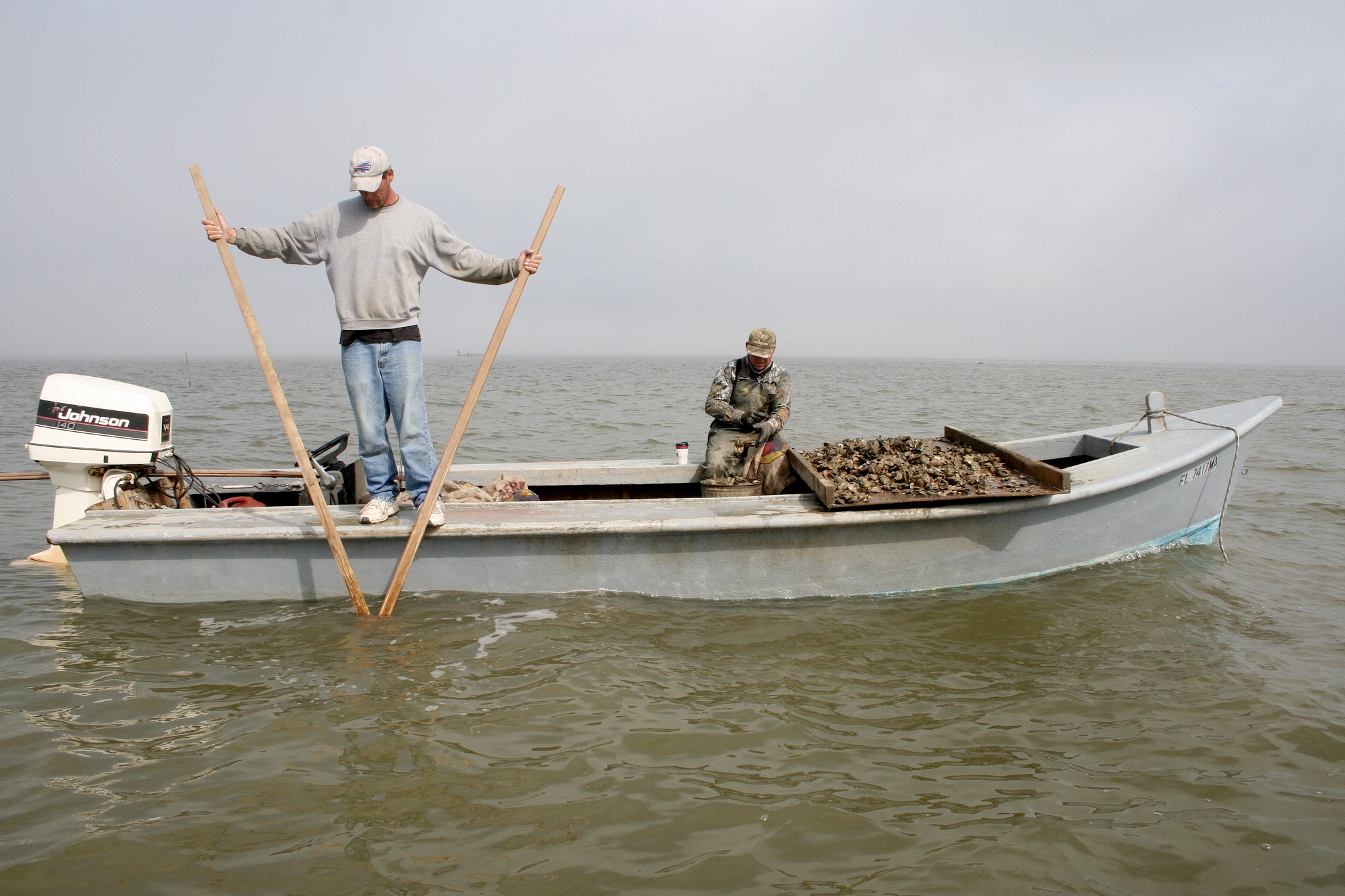 Photo Courtesy: NOAA
Photo Courtesy: NOAA
Climate Considerations in Fisheries Management: An Apalachicola Bay Case Study
A Broader Perspective
Combatting illegal, unreported, and unregulated (IUU) fishing is vital to preserving ocean resources and coastal communities relying on these ecosystems for subsistence. It is infeasible and ineffective to address this issue singularly. A robust policy addressing IUU fishing requires holistic considerations of climate change, population growth, water management, and scalable economic modelling. Lawmakers and stakeholders alike must recognize the complex intersection of costly climate-related externalities and local fisheries depletion.
Apalachicola Bay
Small-scale fishing operations and their surrounding communities are critically dependent on fish for food and economic security, leaving them particularly susceptible to external pressures and shocks. Take Apalachicola Bay, for example, where oyster harvesting has been the economic lifeblood of the town since its inception in 1828. Apalachicola Bay has historically produced nearly 90% of the U.S.’s commercial oyster harvest and is responsible for the third-largest shrimp catch in all of Florida.
Optimal conditions for oyster growth like that in Apalachicola Bay are tough to come by. Topographically, the bay sits as a wide and shallow barrier island estuarine system on the Florida Panhandle, where the Apalachicola River meets the Gulf of Mexico. This freshwater discharge point provides the perfect brackish mix for growing oysters. Tragically, oyster harvest in Apalachicola Bay is now at less than fifty percent of its historic levels, an unfortunate result of the convolution of several climate-driven stressors such as increased upstream water consumption, chemical and oil pollution, and extreme weather events.
Climate Change
Addressing the problem of poor fisheries management is a complicated task that must be understood within the broader context of our rapidly changing climate. The health of our oceans, the longevity of abutting inland waters and tributaries, and the livelihoods of millions of people all depend on well-managed fisheries. Alarmingly, however, the increased uptake of carbon dioxide by oceans due to climate change, resulting in higher water acidity, is concerning for calcifying organisms like oysters in natural environments. Other climate-related concerns, such as competition for water, changes in the water cycle, increased frequency of storms, and sea-level rise are also expected to impact inland fisheries and aquaculture industries.
Climate change impacts significantly jeopardize shoreline communities. In these areas, tidal flooding occurs more frequently, extreme storm events are increasing, the water table is rising, aquifers are saltier, and there are many such indicators of change. Shoreline communities already facing risks of coastal storms will encounter greater instability as sea levels rise. Research suggests an upward trend in the number of sudden weather events facing Floridians in the coming decades. Florida is home to wetlands and marshes providing vital ecosystem services in coastal areas continually plagued by extreme hydrologic events such as hurricanes and drought. These outcomes also harm municipalities in Florida that embody coastal states’ ties to ocean life—Miami, a major U.S. city home to nearly half a million residents, has a 25% chance of having a 100-year flood by 2030 as global warming accelerates. Projections indicate that sea level will rise another 6 inches in the next 15 years. New modelling by Resources for the Future suggests that Florida’s next two decades could be more disruptive than any period in its history, as climate change threatens the state’s 8,500-mile coastline and gradually destabilizes its $1 trillion economy.
Freshwater Runoff
The Apalachicola-Chattahoochee-Flint (ACF) river system is the largest in Florida and the predominant source of freshwater influx into Apalachicola Bay. The river system’s streamflow largely controls the salinity of the bay and, thus, the brackish conditions suitable to oyster population growth.
Saltwater fishing operation and economic security along the U.S. coast are closely tied to freshwater allocations and climate policy. In the last decade, recent upstream development along the Apalachicola River has captured precious freshwater for municipal and agricultural use. As a result, salinity levels in Apalachicola Bay have steadily increased due to decreased streamflow, upsetting delicate ecosystem balances in Florida wetlands where rare marine species have long thrived.
In 2014, Florida and Georgia faced a desperate legal battle for increased streamflow entitlements in the ACF river basin. For Florida, this lawsuit was born from a dire need for increased freshwater in the Apalachicola Bay ecosystem to save the Apalachicola oyster industry. Florida insisted that the decreased streamflow was due to Georgia’s rampant upstream water use in major metropolitan areas; Georgia argued, however, that the bay’s damage was due to climatic changes, Florida’s oyster overharvesting, and Florida’s failure to replace harvested oyster shells.
The Supreme Court held that Florida was not entitled to increased freshwater runoff in Apalachicola Bay based on a finding that oyster populations were dwindling due to other factors under Florida’s control. Among them, the Court cited a myriad of climate-related catastrophes: drought, changing rainfall patterns, hurricane displacement, pesticides in agricultural runoff, the BP oil spill, and oyster overfishing.
Florida v. Georgia spells trouble for states staging future attempts at judicial remedy in the context of water apportionment. As climate disasters and upstream uses increase, it will become more difficult for states to prove their water shortages are due to extra-territorial state action in a landscape of superseding climate-related causes.
A Path Forward
The Florida Wildlife Conservation agency has instituted a complete ban on oyster fishing in Apalachicola Bay until 2025. Local business owners and oyster bars, many of whom have been running bay-front establishments since 1971, will be detrimentally impacted by this standstill. The story of Apalachicola Bay tells a cautionary tale for other domestic coastal communities in which holistic climate collaboration is crucial to preserving local fishing livelihood.
Mitigating the future harms of ecosystem decimation as a result of overfishing requires holistic considerations of comprehensive climate policy, effective water management, and stakeholder participation. Community and intergovernmental collaboration are crucial to a unified response to address the convolution of different climate-related impacts.






